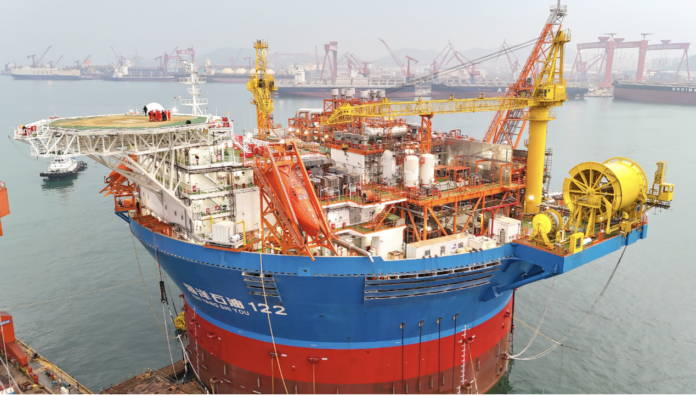BEIJING, June 11 – The first cylindrical floating oil-gas production, storage and offloading (FPSO) facility in Asia, named “Haikui No. 1,” has been successfully installed at sea, its owner, China National Offshore Oil Corporation (CNOOC), announced on Monday.
This achievement marks a significant breakthrough for China in installing floating facilities in deepwater oil and gas fields, according to CNOOC, the largest offshore oil and gas producer in China.
“Haikui No. 1” is a self-developed cylindrical FPSO facility installed in the sea area of the Liuhua Oilfield in the Pearl River Mouth Basin. It extends more than 320 meters deep and is located about 240 kilometers southeast of Shenzhen City.
Weighing a total of 37,000 tonnes and towering at a height of approximately 30 floors, “Haikui No. 1” integrates functions of crude oil production, storage and offloading. It consists of nearly 600,000 components and the size of its main deck is equivalent to that of 13 standard basketball courts. It has a maximum oil storage capacity of 60,000 tonnes, according to CNOOC.
Wang Huoping, deputy general manager of the Liuhua Oilfield development project at CNOOC’s Shenzhen branch, said this is the first time that China has conducted offshore installation of cylindrical marine equipment.
With a design life of 30 years, “Haikui No. 1” is capable of continuous sea operation for 15 years without the need for docking.
Compared to the conventional ship-shaped structure of the FPSO unit, the cylindrical structure design offers advantages such as reduced steel usage, higher oil storage efficiency, and it is better equipped to withstand harsh sea conditions. This effectively improves economic viability and reduces the cost of oilfield development and operations, said Wang.
However, due to its high center of gravity and large windward area, the cylindrical structure is prone to rotation, making offshore installation extremely challenging, he added.
To ensure the stability of “Haikui No. 1” in the turbulent sea, 12 sets of deepwater suction anchors, independently designed and built by China, were installed on the seabed. These anchors are connected by 12 mooring legs. Each leg is 2,570 meters long, with a breaking load of 2,300 tonnes.
This mooring system acts as underwater mooring piles, firmly securing “Haikui No. 1,” said Wang.
















